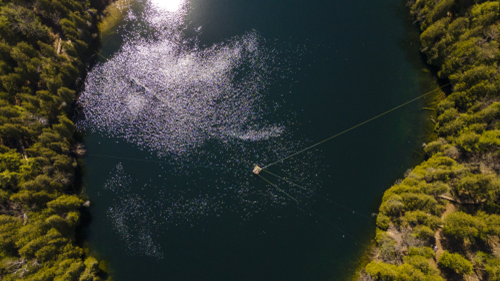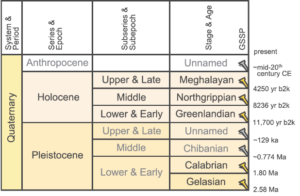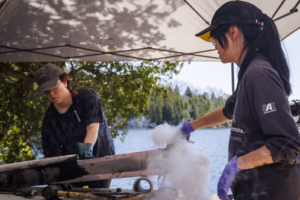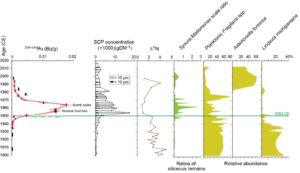NIAGARA ESCARPMENT BIOSPHERE NETWORK BLOG
15/08/2023
Are we living in the Anthropocene? How does the Niagara Escarpment fit into the discourse?
15/08/2023

In 2009, the International Subcommission on Quaternary Stratigraphy (SQS) commissioned a working group to investigate whether the “Anthropocene” had substance as a potential new epoch of geological time. The term was popularized by atmospheric chemist, and Nobel laureate,Paul Crutzen, who insisted that human impact had altered the planet well beyond the norms of the previous 12,000 years — i.e., the Holocene Epoch was over (Crutzen & Stoermer, 2000).
The question remained — when had this tipping point occurred? Over the subsequent decade, Anthropocene Working Group (AWG) members debated the existence of, and merits of potential bases, for this possible new epoch to be defined by a “golden spike.” Crutzen had surmised that Watts’ invention of the steam engine in 1769 might be a useful datum, but the effects of steam engine and other fossil fuel-driven industrial processes are highly diachronous — detected much earlier in western Europe than in Asia, for instance. A globally synchronous transition away from the Holocene state was identified at all twelve sites considered by the AWG as possible Anthropocene candidates: in the mid-20th century, driven by multiple factors including anthropogenic emissions of CO2 during the Great Acceleration (Steffen et al., 2015).

The varved sediments of Crawford Lake were selected by a supermajority of voting members of the Anthropocene Working Group as the candidate to be proposed to the Subcommission on Quaternary Stratigraphy as the GSSP (Global boundary Stratotype Section and Point) to formally define the Anthropocene as a series / epoch on the Geologic Time Scale. Because associated stage / age is always named for the site of the proposed “golden spike,” the “Unnamed” entry above would become “Crawfordian,” if the AWG proposal is approved by the SQS and its parent bodies.
Beginning in 2018, I led the investigation of one of the twelve sites — the meromictic Crawford Lake, near Milton, Ontario — and the following year, I became a voting member of the AWG. Distinct seasonal layers (varves) accumulate on the bed of this idyllic lake that occupies a small(2.4 ha), deep (nearly 24 m) karstic basin weathered in carbonate rocks of the 430-million-year-old Lockport Group caprock of Niagara Escarpment. Calcite crystals formed in the upper part of the water column each summer cap organic matter that sinks to the lakebed the rest of the year, so — like tree rings — these varves provide annual resolution. Sediments from individual years can thus be analysed for physical, chemical and biological markers of Earth System conditions (McCarthy et al., 2023).

“Team Crawford” members Krysten Lafond (Queen’s University) and Anne Nguyen (Carleton University) release a core face from the freeze corer — note the sublimating dry ice in the centre of the hollow corer that allows lakebed sediments to freeze onto the metal face, preserving the annual layers (varves) (above). The core was retrieved moments earlier from the raft above the deep basin of Crawford Lake (drone image of the “Grampie Roy” coring platform in April, 2023, below). Photo credit: Brock University.
AWG members recently selected the varved sediments of the meromictic Crawford Lake as best representing the departure of conditions from Holocene norms (Press Conference | Max Planck Institute of Geoanthropology (mpg.de)), with the coincident rise in plutonium fallout from aboveground nuclear weapons testing as the primary marker for the base of the Anthropocene.Details of this, and eight other sies that vied to be the type section for the Anthropocene, are available (open access) in a special issue of The Anthropocene Review published in 2023.

Summary of key markers of the Great Acceleration (SCPs = fly ash, nitrogen isotopes record changes in atmospheric composition) and the Cold War (plutonium fallout – red = 2019 core, black + 2022 core data) above the proposed base of the Anthropocene in varve age-dated sediments fom Crawford Lake. The biosphere response to these global atospheric changes, primarily resulting from the dramatic increase in fossil fuel emissions (initially without controls),is evident in the fossil record of siliceous algae. Chrysophyte and diatom assemblages record much deeper penetration of light through the water column until air quality standards were enforced to curb acid rain and large concentrations of calcite crystals once again impeded photosythesis deeper in the water column. Modified from McCarthy et al. (2023).
Several distinct intervals of “pre-Anthropocene” impact are recorded in the upper meter of sediments in the karstic basin (including pollen of cultigens and spores of their fungal pathogens in varves dating to the late 13th through 15th centuries and colonial impact and peaking at the end of the 19th century, when the Crawfords operated a lumber mill at the south end of the lake). These impacts were local, however, unlike the global response to the Great Acceleration that resulted in a tipping point in the Earth System. Irrespective of the final decision of the SQS who will evaluate the AWG proposal to formally define the Anthropocene, Crawford Lake now stands as a key site to engage discourse, debate, and evaluation of the effects of humans on planetary systems.
— Francine McCarthy is professor of Earth Sciences at Brock University
Crutzen & Stoermer (2000) IGBP Newsletter 41: 17–18
McCarthy et al. (2023). Anthropocene Review 10(1): 146–176
Steffen et al. (2015). Anthropocene Review 2(1): 81–98